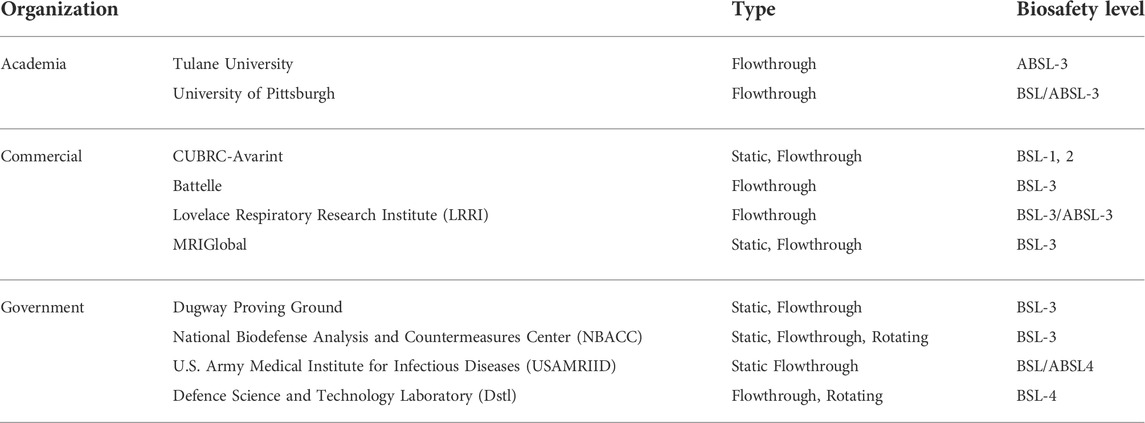A Corrigendum on
Aerosol test chambers: Current state and practice during the COVID-19 pandemic
by Yeh KB and Setser B (2022). Front. Bioeng. Biotechnol. 10:863954. doi: 10.3389/fbioe.2022.863954
In the published article, there was an error in Table 1 as published. The government organization “Defence Science and Technology Laboratory (Dstl)” should be listed as having both Flowthrough and Rotating types at Biosafety level (BSL)-4 instead of BSL-3. The correct Table 1 appears below. The original article has been updated.

TABLE 1. Representative set of aerosol test chambers. The list was derived from open source material.
In the published article, the reference for Beedham and Davies, 2021 was inadvertently included in the last sentence of the last paragraph in the section, “Examples of Related Aerosol Test Chamber Work”. It should be added to the preceding sentence of the same paragraph in the same section.
The sentences previously stated:
“Similar to the United States, foreign governments have entities that focus on infectious disease, to include BWA. An allied counterpart in the United Kingdom is their Defence Science and Technology Laboratory (Dstl) which the Ministry of Defense operates at Porton Down. Prior to the COVID 19 outbreak, Dstl conducted numerous studies using a Rotating Drum to study the stability and viability of aerosolized infectious diseases, including Lake Victoria Marburgvirus, Zaire ebolavirus, and Reston ebolavirus (Piercy et al., 2010, Schuit et al., 2014). Following the COVID 19 outbreak, Dstl used this same capability to study SARS-CoV-2 in saliva and different media at various humidity (Smither et al., 2020; Beedham and Davies, 2021).”
The corrected sentences appear below:
“Similar to the United States, foreign governments have entities that focus on infectious disease, to include BWA. An allied counterpart in the United Kingdom is their Defence Science and Technology Laboratory (Dstl) which the Ministry of Defense operates at Porton Down. Prior to the COVID 19 outbreak, Dstl conducted numerous studies using a Rotating Drum to study the stability and viability of aerosolized infectious diseases, including Lake Victoria Marburgvirus, Zaire ebolavirus, and Reston ebolavirus (Piercy et al., 2010; Schuit et al., 2014; Beedham and Davies, 2021). Following the COVID 19 outbreak, Dstl used this same capability to study SARS-CoV-2 in saliva and different media at various humidity (Smither et al., 2020).”
The authors apologize for this error and state that this does not change the scientific conclusions of the article in any way. The original article has been updated.
Publisher’s note
All claims expressed in this article are solely those of the authors and do not necessarily represent those of their affiliated organizations, or those of the publisher, the editors and the reviewers. Any product that may be evaluated in this article, or claim that may be made by its manufacturer, is not guaranteed or endorsed by the publisher.
References
Beedham, R. J., and Davies, C. H. (2021). The UK Biological-Warfare Program: Dual-Use Contributions to the Field of Aerobiology. Nonproliferation Rev., 27 (4-6), 309–322. doi:10.1080/10736700.2020.1823621
Piercy, T. J., Smither, S. J., Steward, J. A., Eastaugh, L., and Lever, M. S. (2010). The Survival of Filoviruses in Liquids, on Solid Substrates and in a Dynamic Aerosol. J. Appl. Microbiol. 109, 1531–1539. doi:10.1111/j.1365-2672.2010.04778.x
Schuit, M., Ratnesar-Shumate, S., and Kline, J. (2014). “Characterization of a Rotating Drum System for Bioaerosol Studies in Biocontainment,” in 2014 AAAR Annual Conference Abstracts, Proceedings of the 2014 AAAR Annual Conference, October 20-24 (Orlando, FL).
Keywords: aerobiology, aerosol test chamber, bioaerosol, biodefense, biosecurity
Citation: Yeh KB and Setser B (2022) Corrigendum: Aerosol test chambers: Current state and practice during the COVID-19 pandemic. Front. Bioeng. Biotechnol. 10:1036662. doi: 10.3389/fbioe.2022.1036662
Received: 04 September 2022; Accepted: 05 September 2022;
Published: 20 October 2022.
Approved by:
Frontiers in Editorial OfficeCopyright © 2022 Yeh and Setser. This is an open-access article distributed under the terms of the Creative Commons Attribution License (CC BY). The use, distribution or reproduction in other forums is permitted, provided the original author(s) and the copyright owner(s) are credited and that the original publication in this journal is cited, in accordance with accepted academic practice. No use, distribution or reproduction is permitted which does not comply with these terms.
*Correspondence: Kenneth B. Yeh, a3llaEBtcmlnbG9iYWwub3Jn
 Kenneth B. Yeh
Kenneth B. Yeh Bradly Setser2
Bradly Setser2